Related Research Articles

Robert Dennis Crumb is an American cartoonist who often signs his work R. Crumb. His work displays a nostalgia for American folk culture of the late 19th and early 20th centuries, and satire of contemporary American culture.
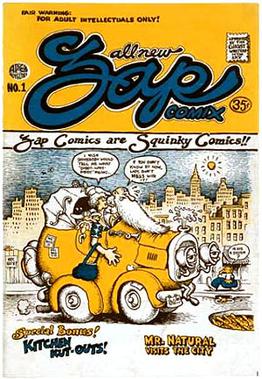
Underground comix are small press or self-published comic books that are often socially relevant or satirical in nature. They differ from mainstream comics in depicting content forbidden to mainstream publications by the Comics Code Authority, including explicit drug use, sexuality, and violence. They were most popular in the United States in the late 1960s and 1970s, and in the United Kingdom in the 1970s.

Dan O'Neill is an American underground cartoonist, creator of the syndicated comic strip Odd Bodkins and founder of the underground comics collective the Air Pirates.

Zap Comix is an underground comix series which was originally part of the counterculture of the late 1960s. While a few small-circulation self-published satirical comic books had been printed prior to this, Zap became the model for the "comix" movement that snowballed after its release. The title itself published 17 issues over a period of 46 years.
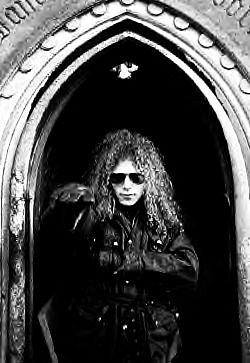
Vaughn Bodē was an American underground cartoonist and illustrator known for his character Cheech Wizard and his artwork depicting voluptuous women. A contemporary of Ralph Bakshi, Bodē has been credited as an influence on Bakshi's animated films Wizards and The Lord of the Rings. Bodē has a huge following among graffiti artists, with his characters remaining a popular subject.
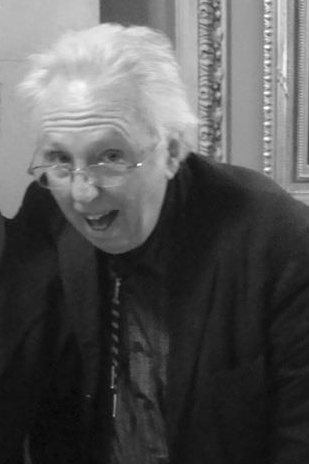
William Henry Jackson Griffith is an American cartoonist who signs his work Bill Griffith and Griffy. He is best known for his surreal daily comic strip Zippy. The catchphrase "Are we having fun yet?" is credited to Griffith.
Shary Flenniken is an American editor-writer-illustrator and underground cartoonist. After joining the burgeoning underground comics movement in the early 1970s, she became a prominent contributor to National Lampoon and was one of the editors of the magazine for two years.
Robert London is an American underground comix and mainstream comics artist. His style evokes the work of early American cartoonists like George Herriman and Elzie Crisler Segar.

The Checkered Demon is a fictional character created by S. Clay Wilson, one of the leading underground comix artists of the 1960s. The character debuted in 1967 in Groulish magazine; his comix debut was in Zap Comix #2, in 1968.

Mr. Natural is a comic book character created and drawn by 1960s counterculture and underground comix artist Robert Crumb. First appearing in Yarrowstalks (1967), the character gained a following during the emergence of underground comix in the 1960s and 1970s, and has been extensively merchandised in various products.

Gary Hallgren is an American illustrator and underground cartoonist. Illustrations by Hallgren have been "commissioned by publications such as The New York Times, Men's Health, The Wall Street Journal, Mad, and Entertainment Weekly, among others."
The Air Pirates were a group of cartoonists who created two issues of an underground comic called Air Pirates Funnies in 1971, leading to a famous lawsuit by Walt Disney Productions. Founded by Dan O'Neill, the group also included Bobby London, Shary Flenniken, Gary Hallgren, and Ted Richards.

Angelfood McSpade is a comic book character created and drawn by the 1960s counter culture figure and underground comix artist Robert Crumb. The character first appeared in the Philadelphia-based underground newspaper Yarrowstalks #2 in July 1967, making her comics debut in the second issue of Zap Comix.
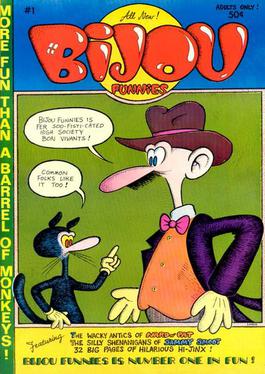
Bijou Funnies was an American underground comix magazine which published eight issues between 1968 and 1973. Edited by Chicago-based cartoonist Jay Lynch, Bijou Funnies featured strong work by the core group of Lynch, Skip Williamson, Robert Crumb, and Jay Kinney, as well as Art Spiegelman, Gilbert Shelton, Justin Green, and Kim Deitch. Bijou Funnies was heavily influenced by Mad magazine, and, along with Zap Comix, is considered one of the titles to launch the underground comix movement.
Theodore Richards was an American web designer and cartoonist, best known for his underground comix.
Chronicle Features was the syndication arm of the San Francisco Chronicle. Syndicating comic strips, newspaper columns, and editorial features, it operated from 1962 to c. 1998. The syndicate was known for the offbeat comic strips it championed, such as Gary Larson's The Far Side, Dan Piraro's Bizarro, and the editorial cartoons of Ted Rall. The service was acquired by Universal Press Syndicate in 1997 and went defunct soon after.

Company & Sons was an early underground comix publisher based in San Francisco, ran by John Bagley. The company operated from 1970 to 1973, publishing a total of 15 titles, all but one of them consisting of a single issue.
Willy Murphy was an American underground cartoonist. Murphy's humor focused on hippies and the counterculture. His signature character was Arnold Peck the Human Wreck, "a mid-30s beanpole with wry observations about his own life and the community around him." Murphy's solo title was called Flamed-Out Funnies; in addition, he contributed to such seminal underground anthologies as Arcade, Bijou Funnies, and San Francisco Comic Book, as well as the National Lampoon.
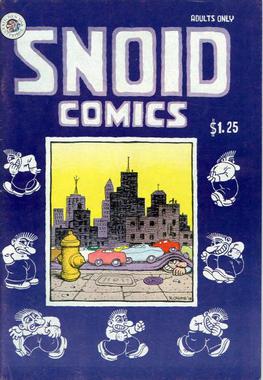
The Snoid, occasionally referred to as Mr. Snoid, is an American underground comix character created by Robert Crumb in the mid-1960s. A diminutive sex fiend and irritating presence, the Snoid often appears with other Crumb characters, particularly Angelfood McSpade, Mr. Natural, and Crumb's own self-caricature.
ProJunior, sometimes styled as Pro Junior, is an American comics character created by Don Dohler in 1958. He debuted in a fanzine in 1961, and in underground comix in 1970. Known as "Baltimore's blasphemous bad boy", the character is unusual in the underground genre for being "shared" by a number of different creators, appearing in stories by Jay Lynch, Art Spiegelman, Skip Williamson, and Robert Crumb. His main period of popularity was from 1970 to 1972.
References
- ↑ Patrick Rosenkranz (2002). Rebel visions: the underground comix revolution, 1963-1975. Fantagraphics Books. ISBN 978-1-56097-464-2.
- ↑ Beck, Jerry (2005). The Animated Movie Guide. Chicago Review Press. p. 66. ISBN 978-1-55652-591-9.
- 1 2 Grandinetti, Fred M. (2004). Popeye: An Illustrated Cultural History. Jefferson, N.C.: McFarland. p. 16. ISBN 0-7864-1605-X . Retrieved 2008-11-22.
- ↑ London, Bobby (March 2011). "Dirty Duck". Playboy. p. 100.